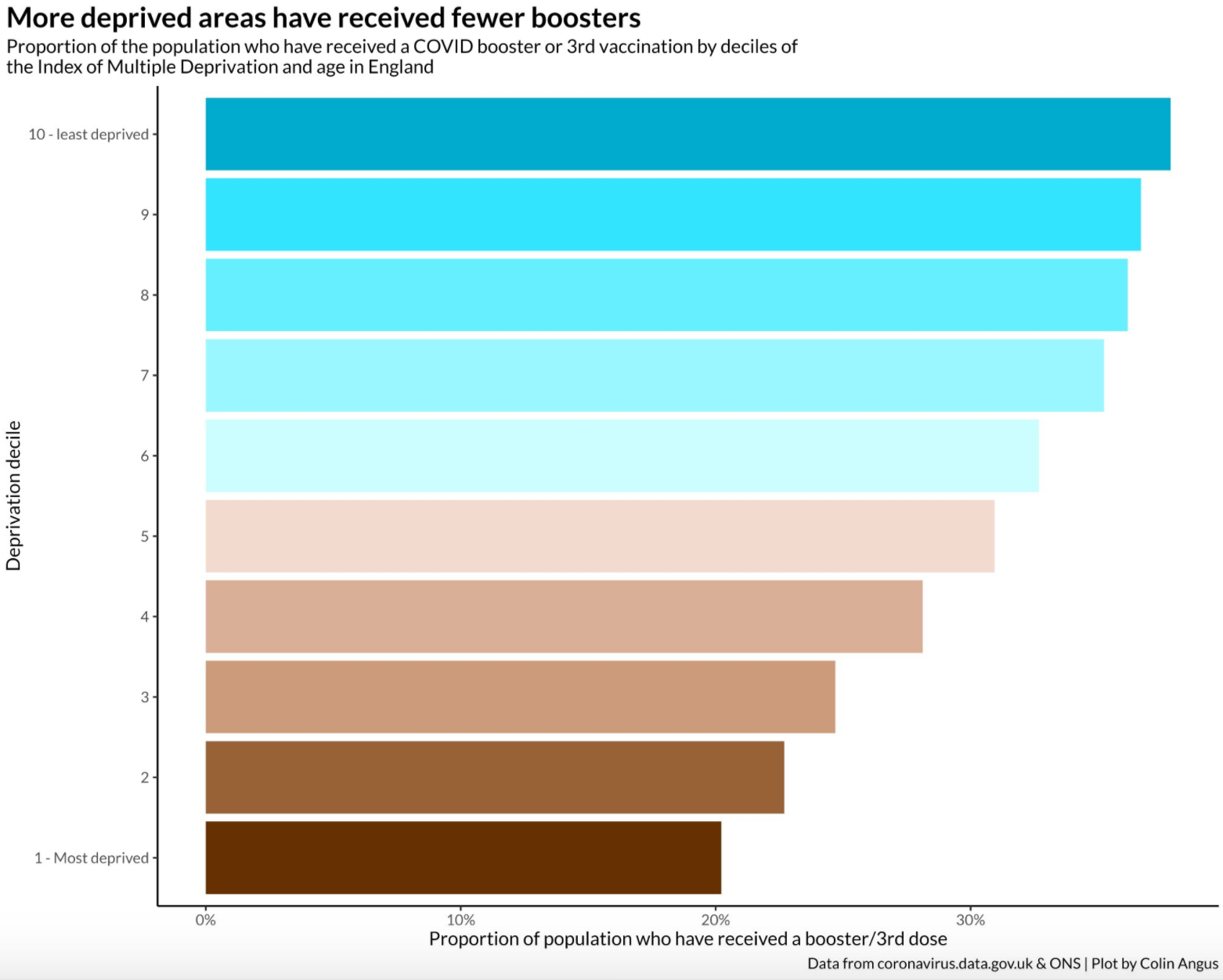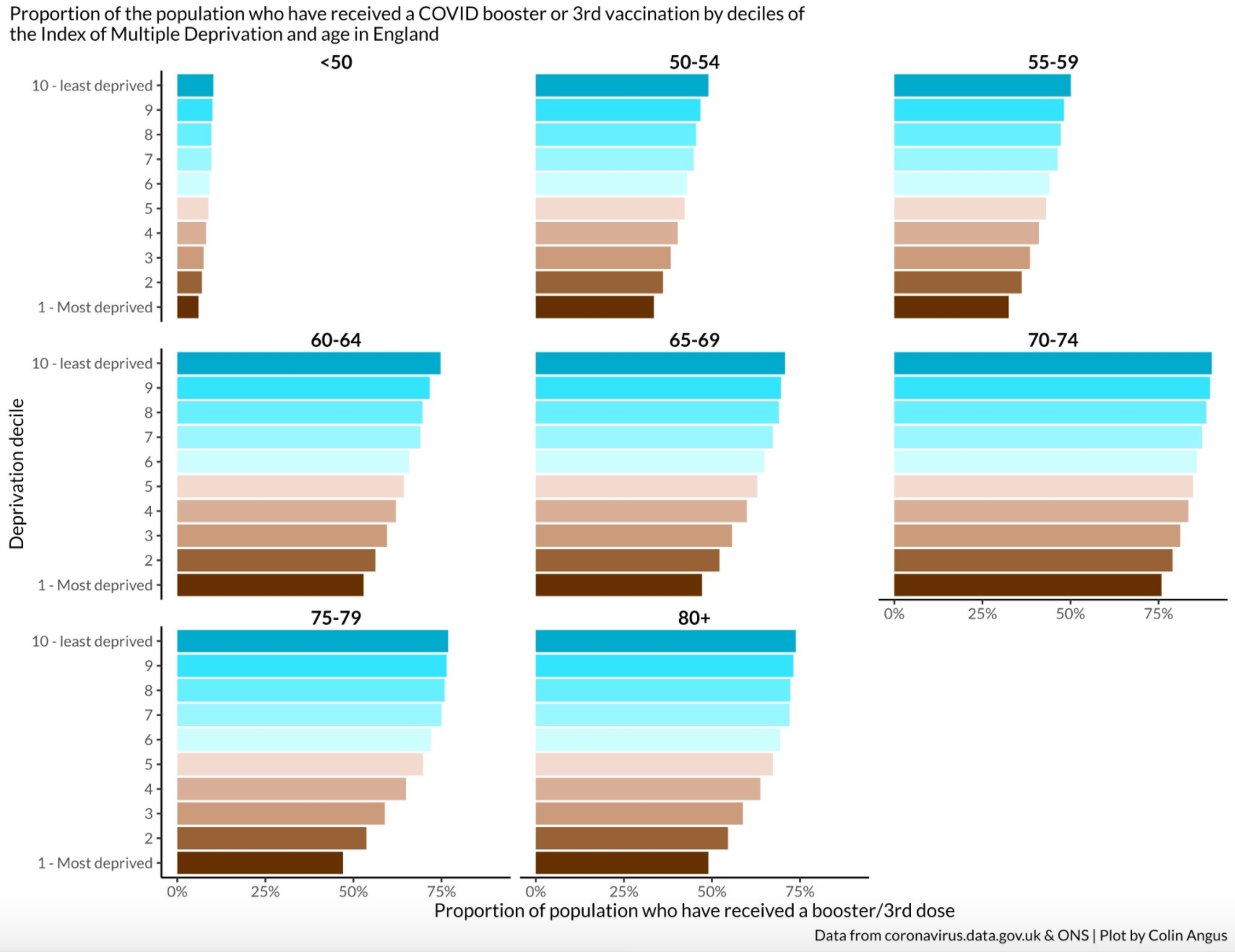England’s poorest to be ‘hardest hit again’ as booster uptake lags amid omicron surge
Exclusive: Just 20.2 per cent of people living in the most deprived areas have received a third dose, compared to 37.8 per cent in the least deprived areas

Your support helps us to tell the story
From reproductive rights to climate change to Big Tech, The Independent is on the ground when the story is developing. Whether it's investigating the financials of Elon Musk's pro-Trump PAC or producing our latest documentary, 'The A Word', which shines a light on the American women fighting for reproductive rights, we know how important it is to parse out the facts from the messaging.
At such a critical moment in US history, we need reporters on the ground. Your donation allows us to keep sending journalists to speak to both sides of the story.
The Independent is trusted by Americans across the entire political spectrum. And unlike many other quality news outlets, we choose not to lock Americans out of our reporting and analysis with paywalls. We believe quality journalism should be available to everyone, paid for by those who can afford it.
Your support makes all the difference.Booster uptake is lagging among the most deprived areas in England, analysis shows, raising concerns that the poor are going to be “hardest hit again” by Covid as the omicron wave intensifies.
As the UK reported 78,610 new infections on Wednesday – the highest daily total recorded since the pandemic began – experts warned that the new variant “has the potential the repeat the inequality of the initial waves”.
Just 20.2 per cent of people living in the most deprived areas of England have received a booster, equating to 1.1 million individuals, compared to 37.8 per cent, or 2.1 million, in the least deprived areas.
Over the summer, there had been signs that the unequal impact of Covid on lower-income communities, who had born the brunt of the pandemic, was beginning to fade.
“The most deprived groups had suffered so badly in early waves that they potentially had an advantage in terms of greater natural immunity,” said Colin Angus, a senior research fellow and health inequalities modeller at the University of Sheffield.
However, given omicron’s apparent ability to reinfect those who have been double-jabbed, it is feared that the variant will spread quicker and further among the poorer parts of England where booster uptake is low.
“Throughout this pandemic the most deprived groups have suffered the most through a combination of many factors, including being more likely to have a public-facing job where you can’t work from home, living in more crowded conditions and being less financially able to take time of work to isolate,” said Mr Angus.
These factors haven’t gone away, he said, which means the most deprived will “be the hardest hit again” if the roll out of boosters among these communities isn’t accelerated. “Omicron has the potential to repeat the inequality of the initial waves all over again.”
His modelling shows the disparities in booster uptake plays out along age groups, too. The analysis shows that less than 50 per cent of over-75s living in England’s most deprived areas have been boosted, compared to around 75 per cent for the least deprived.

In the 70- to 74-year-old group, over 75 per cent of people across all deprivation deciles have been triple-jabbed, the research shows.
Vaccine hesitancy is unlikely to be the driving factor behind the slow uptake rates in poorer communities, Mr Angus said.
Having the time off work and the means to get vaccinated is “likely to be a bigger issue”, he said, adding: “If you don’t have a car, or can’t afford public transport and your nearest vaccine centre isn’t just round the corner, then it’s going to be harder for you.”
Professor Dominic Harrison, director of public health for Blackburn with Darwen Council, said vaccination uptake was poor among the region’s lower-income communities and those areas with large ethnicity minority populations.
Despite the recent guidance to work from home, this recommendation is unlikely to slow the spread of omicron in parts of the North West where people have no choice but to continue working in offices or factories, he said.
Prof Harrison pointed to areas of Pennine Lancashire, where only “around 20 per cent” of adults can work from home. In contrast, 73 per cent of adults in Richmond upon Thames have the “luxury of being to work to work from home”.
“We have more people out in frontline work exposed to circulating viruses in transport, food production, logistics etc, who are often lower paid but keeping society going,” he said.

“The deep inequality and unfairness that had been managed by the middle of this summer – that risk will resurface in those northern towns. They will have higher case rates [from omicron] because they’ve got more people out on the frontline.”
How these higher rates translate into pressures on the NHS has yet to be determined by officials. Protection against severe omicron infection for those double-jabbed with the Pfizer vaccine appears to have been reduced from 90 per cent to 70 per cent.
However, scientists are confident that three doses of any vaccine restrengthens the immune’s defences and restores protection against infection, hospitalisation and death to high levels.
Even if the UK’s vaccine wall stands up, leading instead to “mass sickness of people who are not ill enough to end up in hospital,” this could still “deliver a substantial shutdown of public services and slowing of economic activity,” said Dr Simon Clarke, associate professor of cellular microbiology at the University of Reading.
Alice Wiseman, director of public health for Gateshead, said the “full impact” of omicron within communities – in terms of which groups fall ill, the extent of their illness and the knock-on effect on health services and local economies – won’t become clear until January.
“If the vaccines hold up as they did against delta, we’ll be in position where there’s pressure, but probably pressure that we can just about manage. If omicron does escape vaccine protection considerably, it worries me what might happen after Christmas.”
In total, 43 per cent of the UK population has been boosted. However, over 6 million people aged 50 and over in England have yet to receive a third dose, according to the latest data. This figure runs to 5 December and is expected have fallen following the government’s recent booster push.
But the speed with which the new variant is ripping through London, where hospitalisation admissions are now rising amid the county’s highest omicron rates, has sparked concern of what lies ahead for the whole country.
“I’m afraid we have to be realistic that records will be broken a lot over the next few weeks as the rates continue to go up,” Professor Chris Whitty, England’s chief medical officer, told a Downing Street briefing on Wednesday evening.
“What we’ve got is two epidemics on top of one another – an existing Delta epidemic, roughly flat, and a very rapidly growing omicron epidemic on top of it.”
Join our commenting forum
Join thought-provoking conversations, follow other Independent readers and see their replies
Comments